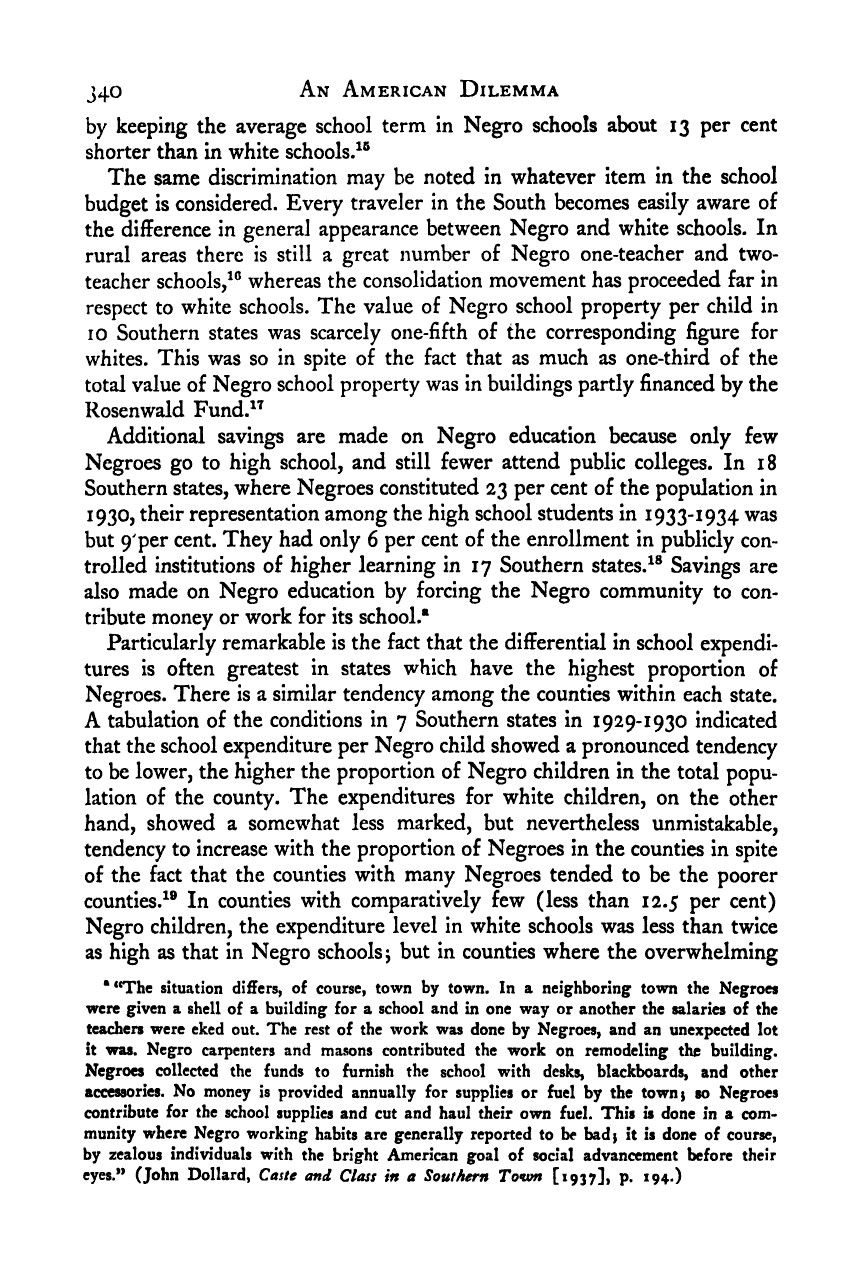Note: Gunnar Myrdal died in 1987, less than 70 years ago. Therefore, this work is protected by copyright, restricting your legal rights to reproduce it. However, you are welcome to view it on screen, as you do now. Read more about copyright.
Full resolution (TIFF) - On this page / på denna sida - IV. Economics - 15. The Negro in the Public Economy - 3. Education

<< prev. page << föreg. sida << >> nästa sida >> next page >>
Below is the raw OCR text
from the above scanned image.
Do you see an error? Proofread the page now!
Här nedan syns maskintolkade texten från faksimilbilden ovan.
Ser du något fel? Korrekturläs sidan nu!
This page has never been proofread. / Denna sida har aldrig korrekturlästs.
An American Dilemma
J40
by keeping the average school term in Negro schools about 13 per cent
shorter than in white schools.^®
The same discrimination may be noted in whatever item in the school
budget is considered. Every traveler in the South becomes easily aware of
the difference in general appearance between Negro and white schools. In
rural areas there is still a great number of Negro one-teacher and two-
teacher schools/^* whereas the consolidation movement has proceeded far in
respect to white schools. The value of Negro school property per child in
10 Southern states was scarcely one-fifth of the corresponding figure for
whites. This was so in spite of the fact that as much as one-third of the
total value of Negro school property was in buildings partly financed by the
Rosenwald Fund.^"^
Additional savings are made on Negro education because only few
Negroes go to high school, and still fewer attend public colleges. In 18
Southern states, where Negroes constituted 23 per cent of the population in
1930, their representation among the high school students In 1933-1934 was
but 9’per cent. They had only 6 per cent of the enrollment in publicly con-
trolled institutions of higher learning in 17 Southern states.^® Savings are
also made on Negro education by forcing the Negro community to con-
tribute money or work for its school.*
Particularly remarkable Is the fact that the differential in school expendi-
tures is often greatest in states which have the highest proportion of
Negroes. There is a similar tendency among the counties within each state.
A tabulation of the conditions In 7 Southern states in 1929-1930 indicated
that the school expenditure per Negro child showed a pronounced tendency
to be lower, the higher the proportion of Negro children in the total popu-
lation of the county. The expenditures for white children, on the other
hand, showed a somewhat less marked, but nevertheless unmistakable,
tendency to increase with the proportion of Negroes in the counties in spite
of the fact that the counties with many Negroes tended to be the poorer
counties.^® In counties with comparatively few (less than 12.5 per cent)
Negro children, the expenditure level in white schools was less than twice
as high as that In Negro schools j
but in counties where the overwhelming
‘“The situation differs, of course, town by town. In a neighboring town the Negroes
were given a shell of a building for a school and in one way or another the salaries of the
teachers were eked out. The rest of the work was done by Negroes, and an unexpected lot
it was. Negro carpenters and masons contributed the work on remodeling the building.
Negroes collected the funds to furnish the school with desks, blackboards, and other
accessories. No money is provided annually for supplies or fuel by the town) so Negroes
contribute for the school supplies and cut and haul their own fuel. This is done in a com-
munity where Negro working habits are generally reported to be badj it is done of course,
by zealous individuals with the bright American goal of social advancement before their
eyes.” (John Dollard, Caste and Class in a Southern Tovm [1937], p. 194.)
<< prev. page << föreg. sida << >> nästa sida >> next page >>